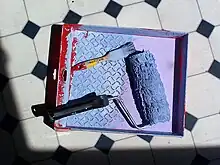Paint roller
A paint roller is a paint application tool used for painting large flat surfaces rapidly and efficiently.

The paint roller typically consists of two parts: a "roller frame," and a "roller cover." The roller cover absorbs the paint and transfers it to the painted surface, the roller frame attaches to the roller cover. A painter holds the roller by the handle section. The roller frame is reusable. It is possible to clean and reuse a roller cover, but it is also typically disposed of after use.
The roller cover is a cylindrical core with a pile fabric covering secured to the cylindrical core. Foam rubber rollers are also produced. There are both foam and fabric rollers that are individually available (without a handle), made to replace worn out rollers, once an old roller is removed the new roller can be fitted onto the handle section for use. An innovation of the cylindrical core has allowed it to contain paint inside, with the cover absorbing paint from the inside and filtering it through (naturally by wicking) to be applied externally, when the roller is rolled.
History
Norman James Breakey
In Canada, Norman James Breakey invented a paint roller in 1940, had it patented in Canada,[1] and produced it in a home factory.[2] After WW II, he sold at least 50,000 of the paint rollers under the name Koton Kotor and it was also sold as the TECO roller by Eaton's.[2]
Richard Croxton Adams
In the United States, Richard Croxton Adams produced a paint roller in a basement workshop in 1940[3] and patented it in the United States. The patent application was filed in 1942.[4] However, a similar paint roller patent application was filed in the United States two years earlier in 1940 by inventor Fride E. Dahstrom.<ref>U.S. Patent 2,298,682
References
- John Melady (2013). Breakthrough!: Canada's Greatest Inventions and Innovations. Dundurn. pp. 88–94.
- "Man of Mystery; Norman Breakey, paint roller inventor". Brandon Sun. Manitoba, Canada. 19 April 1975. p. 11.
- "PASSINGS : Richard C. Adams; Inventor of Paint Roller". Los Angeles Times. 14 March 1988.
- U.S. Patent 2,411,842